What are the groups and classes?
Despite all the apparent fragility, the orchid remains one of the most durable flowers. Many varieties are easy to grow in an apartment near a window, if you know the basic rules of care, because home conditions are too different from the flower’s homeland – rainy tropics, cool mountains, deciduous forests. It would be useful to know how much light and heat these delicate plants receive with ideal care, what quality of water is needed, how to spray them and protect them from diseases and pests.
There are more than 30 thousand species of wild orchids and 200 thousand hybrid varieties on our planet. Every year, breeders develop about 400 new hybrids. But absolutely all known orchids can be divided into two groups. Depending on the nature of flowering, they are divided into monopodial and sympodial.
Monopodial – orchids whose long stem grows upward. At the base of the shoots are succulent fleshy leaves containing microelements and nutrients. As they grow, the lower old leaves fall off, and the young ones open higher up the stem. They do not have pseudobulbs or rhizomes. The apical bud of these orchids is preserved throughout life.
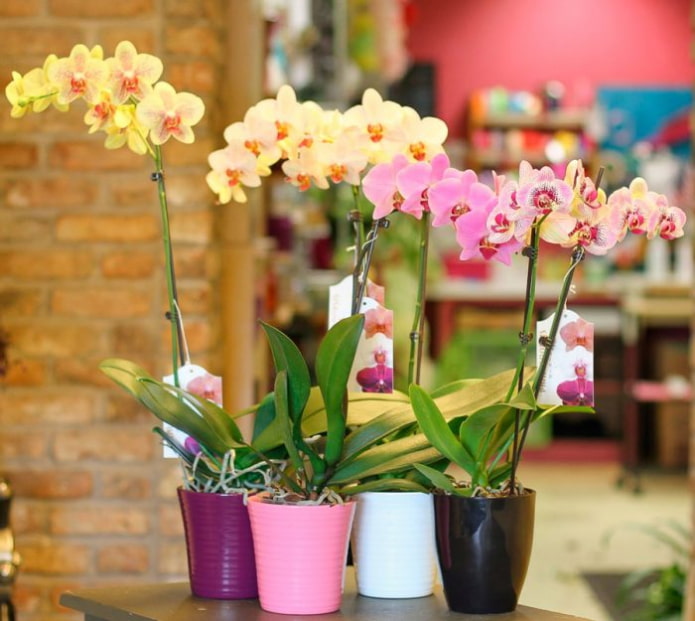
The stem of monopodial orchids can be of very different lengths – very long, medium, like Vanda, quickly stretching (Vanilla) and very short (Phalaenopsis). The latter has such a short stem and grows so slowly that the leaves gather at the top in a rosette. In orchids that do not have tubers, moisture accumulates in the stem and leaves. That is why they are so thick, leathery and juicy. The color of the leaves is most often green, although you can also find variegated varieties.
These include:
- Brassavola;
- Angraecum;
- Vanda;
- Phalaenopsis;
- Vanilla;
- Vandopsis;
- Sarcochillus.

Sympodial – resemble a creeping liana or a creeping grape vine, they grow horizontally. A characteristic feature of sympodial orchids is a large number of shoots or pseudobulbs growing in a horizontal plane. All of them are united by a rhizome with internodes. The plant develops by forming new buds, from which new pseudobulbs are formed over time.
Note! Pseudobulbs can be oval, round, flattened or elongated
A pseudobulb lives for 2-3 years. Then it turns yellow and dies. The leaves of sympodials are thin, often narrow, and as they age, they die off much faster than those of monopodials.
The orchid will bloom if you provide it with a period of dryness and coolness; you must stop watering for 2-2.5 months. During this period, the flower feeds on the moisture accumulated in the pseudobulb bulbs.
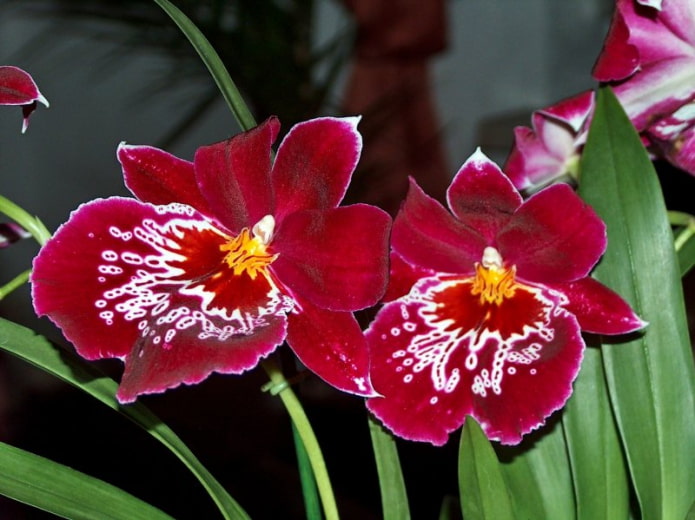
Sympodial flowers include:
- Cattleya;
- Miltonia;
- Oncidium;
- Dendrobium,
- Lelia;
- Carrot orchid.
Cascade or ampelous – is a long slender stem with abundantly blooming flowers and lush inflorescences.
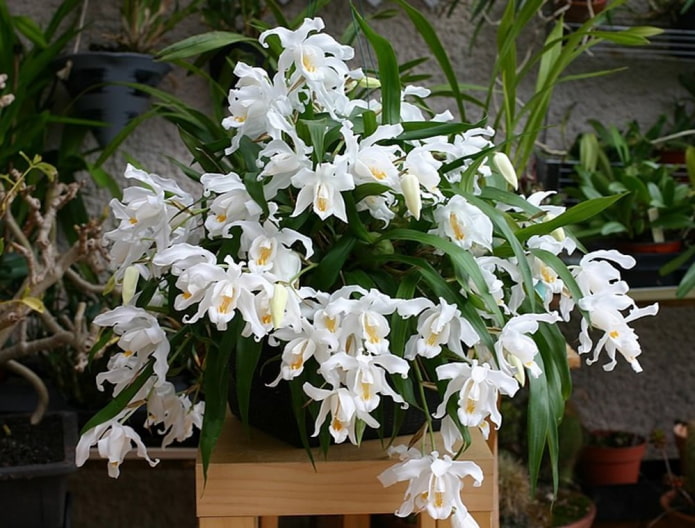
Types of ampelous orchids:
- dendrobium;
- grammatophyllum;
- cymbidium;
- coelogyne.
Attention! A healthy underground root of the plant has a light green hue, the aerial root is gray, with shiny scales. They are supposed to be elastic and dense.
What varieties are there?
If someone decided to write a book about these amazing plants, the result would be weighty volumes of an encyclopedia, unfinished at that. The list of orchid names alone could fill a thick catalog. Considering that new, previously unknown plant varieties are still being discovered in tropical forests, and that breeders regularly produce new flowers, the topic can be called inexhaustible.
But you shouldn’t get lost. An ordinary gardener is unlikely to come across rare varieties that require complex care, and it’s easy to figure out the most popular ones by simply reading the information we offer.
Note! Hybrid orchids are the most resistant to growing at home
Cambria
Cambria includes several natural varieties and hybrids, the “ancestors” of which are 3-4 orchid varieties. Sometimes they differ so much from each other in size, color and shape that you might think they are different flowers. All cambria have sympodial growth. Flowers of various shapes and colors with a diameter of up to 10 cm.

Note! When buying, pay attention to the pseudobulbs. A quality plant should have at least three of them. If there is only one tuber, do not buy it – such an orchid will wither after flowering.
Dendrobium
A bunch of tenderness that takes your breath away – this is how you can call this ephemeral orchid. Translated from Latin, dendrubium means “living on a tree”. Dendrobium is found in South Asia and Australia, in nature it grows on tree trunks and branches. The stem of the plant is cylindrical, completely covered with flowers. The flowers themselves can be of completely different shapes, colors and sizes. The most popular are Dendrobium Nobile and Dendrobium Noble, which feel wonderful in a home atmosphere.
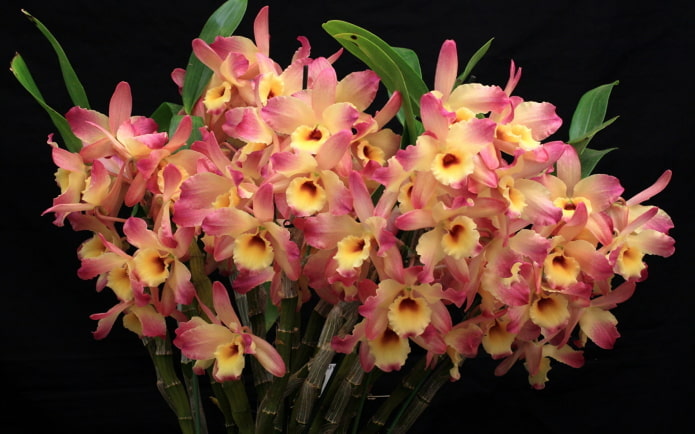
A favorite among orchid lovers is the lilac or purple Dendrobium Phalaenopsis. Another amazing species is Dendrobium bouquet-flowered. It lives at an altitude of 2 thousand meters, exudes a delightful aroma of honey and grass, is distinguished by lush flowering and a marvelous combination of shades.
The fragrant flower blooms so abundantly that each peduncle is a bouquet. The yellow lip with a little fluff stands out nicely against the background of the petals. The photo shows Dendrobium positanium.
Cattleya
Cattleya is beautiful and unpretentious, easily adapts to home conditions. Therefore, it has many fans who prefer to grow a magnificent flower and admire it endlessly. The plant is named after the tropical flower lover William Cattleya. He was the first to achieve flowering of this orchid in his greenhouse.
Cattleya has sympodial development, flowers of amazing shape spread a delicate aroma, painted in all unimaginable and conceivable colors – snow-white, purple, pink, ruby-red, fuchsia, green. The edges of the petals are carved, velvety. The peduncle is relatively short, up to 20 cm.
Cattleya is so delightful that it has been chosen as a symbol of some countries that are in love with it: Cattleya mossiae is the national flower of Venezuela, Cattleya trianae – of Colombia.
Note! Only those Cattleyas that have at least 4 bulbs bloom. A healthy flower in the right conditions will certainly bloom again after a dormant period.
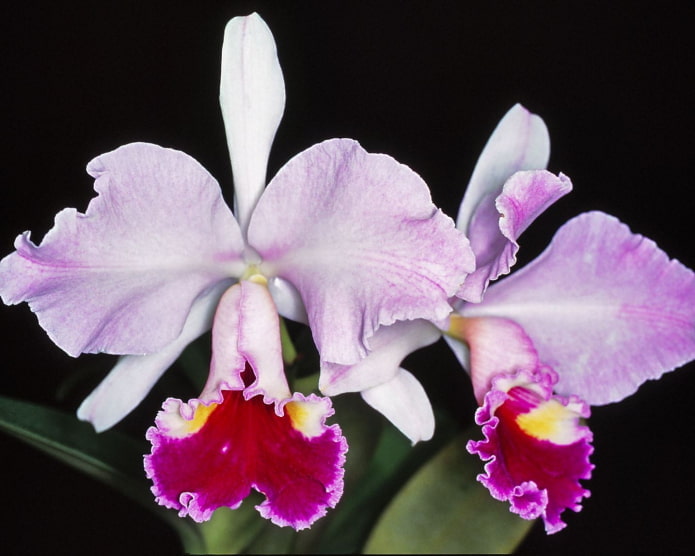
Cymbidium
“Kings of fragrances,” as Confucius called them – evergreen epiphytes from the Orchid family, found in Asia and Northern Australia. Cymbidium decorates the house not only with beautiful flowering, but also fills it with a unique pleasant aroma. The smell of the orchid will delight you for 2 months. The color palette of Cym is amazingly rich – flowers are cream, white, yellow or yellowish-green, green, brown, bright red and pale pink.
Varieties of Cymbidium: Eburneum with the aroma of lilac, Aloelistny, Deya, etc.
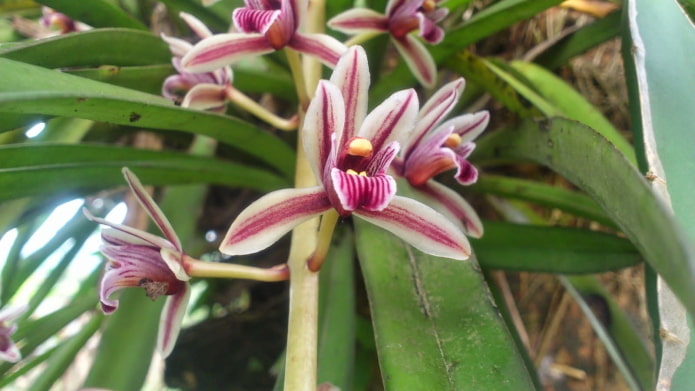
Phalaenopsis
Phalaenopsis are the most unpretentious and popular plants for home breeding, they are leaders among indoor orchids. Beginners are advised to start growing orchids with them. The plant receives moisture and nutrients from the roots. The most valuable orchids were considered to be those with white or pure pink large round flowers on high strong peduncles.
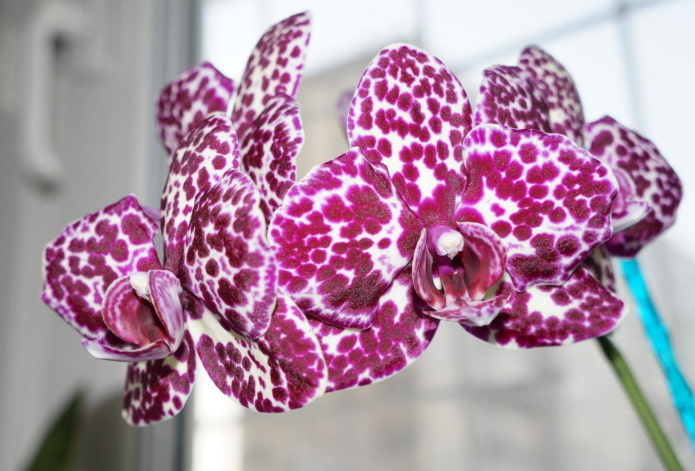
Carl Linnaeus was so impressed by the beauty of this epiphyte from the Orchid family that he called it Epidendrum amabile (charming epidendrum) in his work. Phalaenopsis flowers look like butterflies, and they got their name in their honor. Botanist Karl Blume, looking at the twilight jungle through binoculars, confused orchids with moths. Phalaenopsis translates as “butterfly-like”.
The color palette of Phalaenopsis shows the world the whole range of white to deep purple. Pink representatives of the species open buds on the peduncle at the same time. One day you can wake up and go crazy from the sight of beauty with a fully opened brush and a dizzying smell.
Note! Miniature specimens (up to 20 cm) look very elegant compared to standard counterparts, whose height is from 70 cm to 1 meter.
Lycasta
Only 30-40 species of this species are suitable for growing on a windowsill. The usual sizes of many Lycasta are too large, they are grown in a greenhouse or winter garden. The plant is truly magnificent, its beauty often eclipses the beauties of Phalaenopsis. Colors vary from white to soft pink, and green to light brown.
Flowers up to 15 cm in diameter. According to one version, Lycaste was named after Priam’s daughter, she was mentioned by Homer in the “Odyssey”. Distribution area – Andes, Mexico, Ecuador, Cuba, Jamaica. Where Lycaste comes from, there is constant humidity, while the climate can be warm or cool.
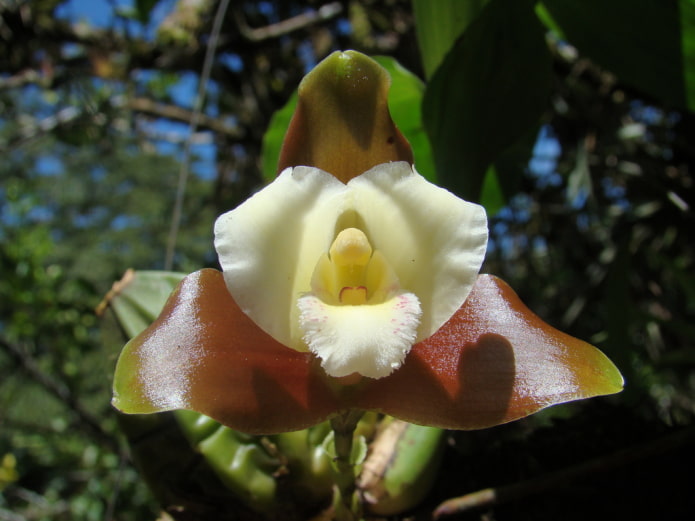
Odontoglossum
A very unusual type of orchid native to Central and South America. What are the colors worth! White with red specks and a yellow lip, lilac with brown and brown wonderful patterns, light yellow with a coffee ornament – you will not see this anywhere else. However, Odontoglossum is very complex and it will not be easy for a beginner to care for it. More often, the orchid can be found in a botanical garden or greenhouse.
Varieties: Bictonian, Heart-shaped, Lemon.

Zygopetalum
The plant has relatively few species – only 15. It develops like a ladder. Translated from Greek, Zygopetalum means “petal to petal”. And, indeed, the sepals and petals of the corolla of the flower at the base have merged and are connected by a narrow bridge. But the eye still stops at the lip: it is bright, stands out in color and shape, similar to the wings of an angel or an open fan. The white background is framed by purple stripes, strokes or inclusions.
The pseudobulbs are comfortably located in the pot, like in a nest, new ones appear above and on the side of the old ones. The average diameter of the flower is 8 cm. It is unclear why there are not so many people willing to tinker with this colorful beauty – it cannot be called too capricious. If desired, you can achieve brilliant results in home cultivation. It is worth trying not only for its beauty, but also for the smell of the orchid – it smells like a daffodil, especially strong – early in the morning.

Vanda
Another perfect beauty from the Orchid family. Vanda is famous for its luxurious inflorescences. Fragrant large flowers attract attention with a wide range of different colors and shades: purple, blue, white, purple, orange. The petals are covered with a mesh of a more expressive tone or light specks. Vanda never rests and can bloom at any time of the year. Cut flowers remain fresh for more than two weeks – so feel free to give them to your loved ones.
The plant is native to the humid tropical forests of Thailand, Australia, India, the Philippines and China. There are 53 known species of Vanda. They are a real gift for breeders, as they are easy to crossbreed. The resulting hybrids are remarkably adapted for home cultivation.
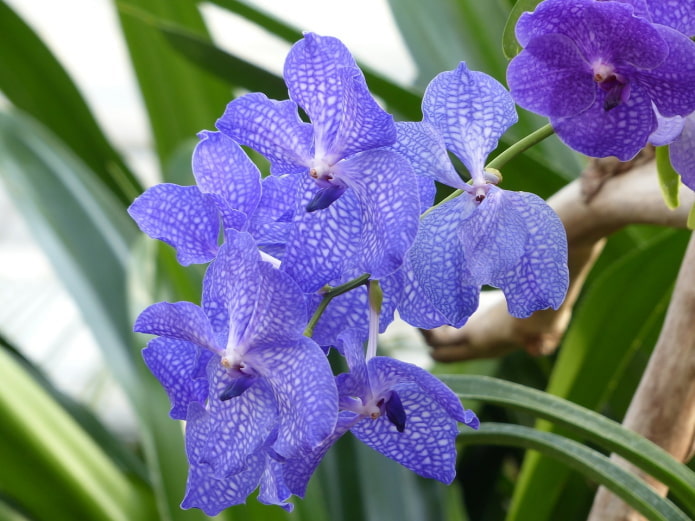
Interesting! Vanda flowers, collected in an inflorescence, have a peculiarity – after blossoming, they continue to grow in size and acquire a deeper color saturation. Currently, breeding work is underway to develop hybrids with the participation of Vanda.
Coelogyne
This imposing beauty is rarely found among home gardening enthusiasts. The reason is insufficient space for growing, and some are simply not confident in their ability to cope with it. In fact, Coelogyne is quite easy to care for. The plant got its name due to its shape. Translated from Greek, koilos is a hollow and gyne is a woman. They have slightly oval pseudobulbs and round, hollow stems.
Large flowers up to 10 cm in diameter bloom on the peduncle, having a wide variety of colors. The shoots are fed by the reserve of old bulbs. There are white varieties, soft green, yellow, cream, sometimes with purple blotches. Very popular is Cristata from the Himalayas and Massange, whose homeland is the Malay Archipelago. Coelogynes smell amazing, the smell of many subspecies is delicate and not cloying.
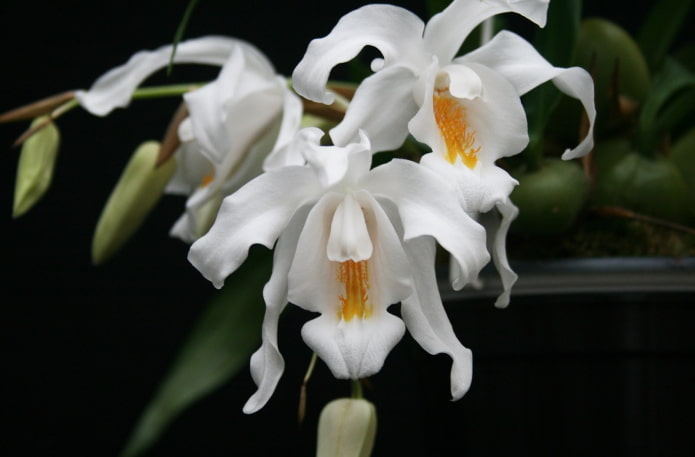
Lelia
It is considered the most delicate of orchids. Graceful, with large flowers, it looks very elegant. Graceful, with a bright palette of pink-purple flowers, with delicate splashes of white, cherry and yellow, it stands out noticeably against the background of other orchids. Loves coolness and fresh air, flowers bloom exclusively in winter.
The plant has only 23 species. Lelia is often confused with Cattleya. They are indeed similar, but the former has longer, graceful peduncles, which can reach half a meter in height. The flowers are large, capable of captivating and impressing with color combinations. The overwhelming majority of Lelias have a pleasant aroma.
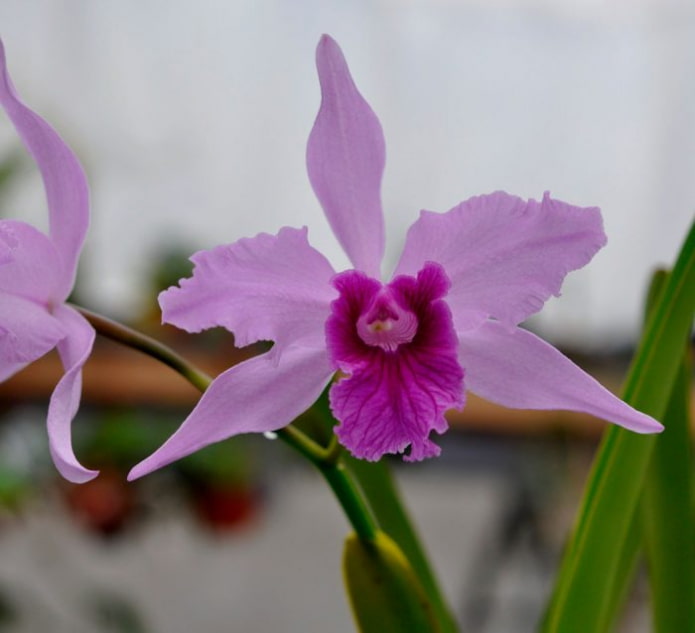
Oncidium
Fragile cheerful flowers, or as they are also called “dancing dolls”, grow in the south of Florida, the Antilles and in South America. Many people love Oncidium because of the duration of flowering – it lasts more than a month.
However, the plant is quite capricious, due to improper watering it can die. Flowers can be large, there is also a scattering of small inflorescences. The most common color range is bright yellow, red and brown shades.
Attention! Watering stops when the first pseudobulb begins to form.
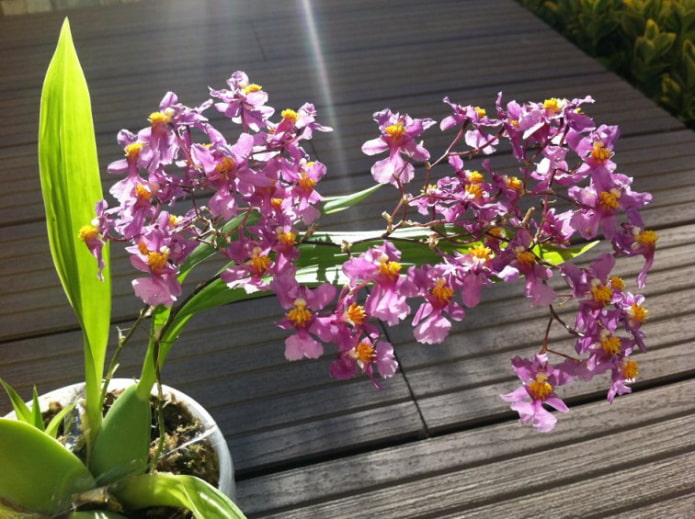
Vanilla
Translated from Latin, vanilla means: vainilla – “pod”. This tasty and aromatic orchid comes from Mexico. According to history, the Aztecs fried and boiled it, mixed it with cocoa, drank and ate it for its medicinal properties. For a long time, they tried to cultivate it in other countries, but to no avail – it took root, but in the tropical forests of Mexico it was pollinated by melipona bees, which are not found in other countries.
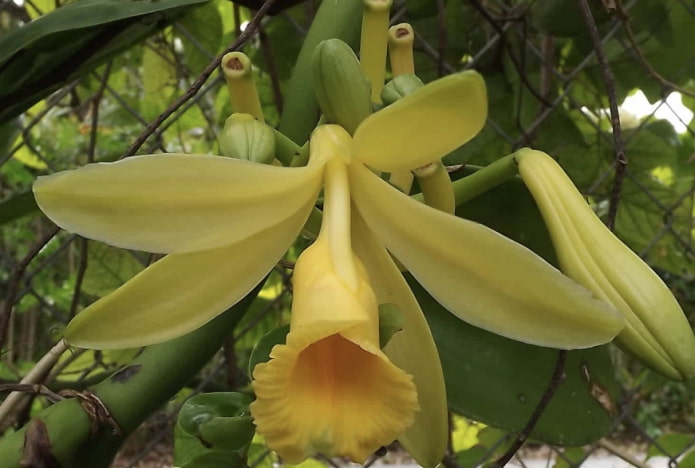
Only in the middle of the 19th century, a teenage slave from Reunion Island found a way to pollinate Vanilla by hand. Since then, this island has become the largest supplier of the spice, without which neither world cuisine nor perfumery can do. In the photo, you can see how Vanilla grows. Melipona must have time to pollinate the flower within 24 hours, otherwise it dies and falls off. And from the pollinated flower comes the fruit-pod.
Brassia
This unusual orchid was named “spider orchid” and for good reason. Brassia seems to throw up long and narrow petals and sepals. Their shape resembles the legs of a spider. It often becomes a houseplant, as it is valued for its ease of maintenance, unusual petal shape and fruitful flowering.
Note! For Brassia, it is recommended to create conditions close to natural: temperatures up to 22-25°C, lots of light and good humidity.

Ludizia
Ludizia or Ludisia belongs to the group of so-called “precious orchids”. The peculiarity and value of the plant is not in the beauty of its flowers, but in its unique leaves. The foliage is velvety, shiny, variegated, and retains its decorative appearance for three years. The leaves have beautifully highlighted veins of golden and silver colors. Snow-white buds are collected in small inflorescences.
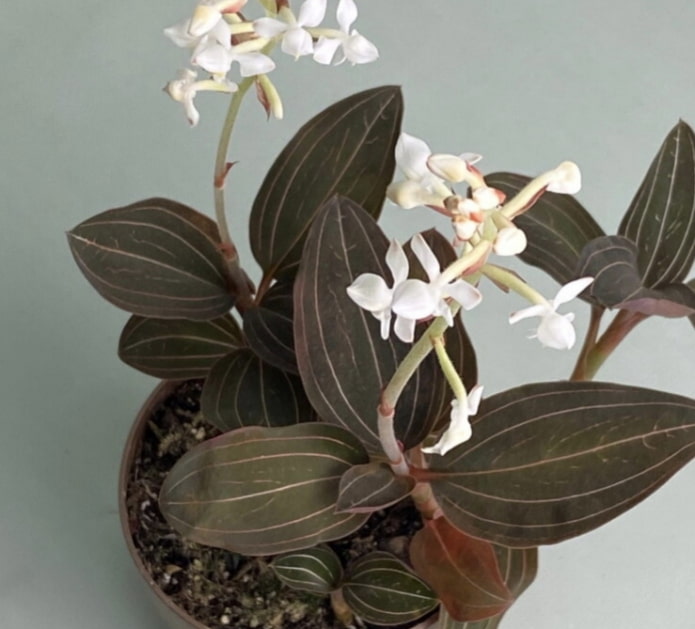
The precious orchid exudes a pleasant scent that fills the entire room. The plant is native to Asia, Madagascar and Australia. The photo shows how simple the flowers seem against the backdrop of magnificent foliage.
Catasetum
Catasetums are epiphytic plants with short creeping stems. They are also called “carrot orchids”. Catasetums have oval pseudobulbs, the stems are tightly pressed to the soil. The leaf blades are bright green, leathery, thin, pointed, the longitudinal veins are clearly visible. There are 150 known species of the flower.
Attractive aroma, bright colors, original flower shapes, completely different peduncles on one plant, and pseudobulbs in the shape of a carrot – all together encourage gardeners to settle a wonderful orchid in their home.
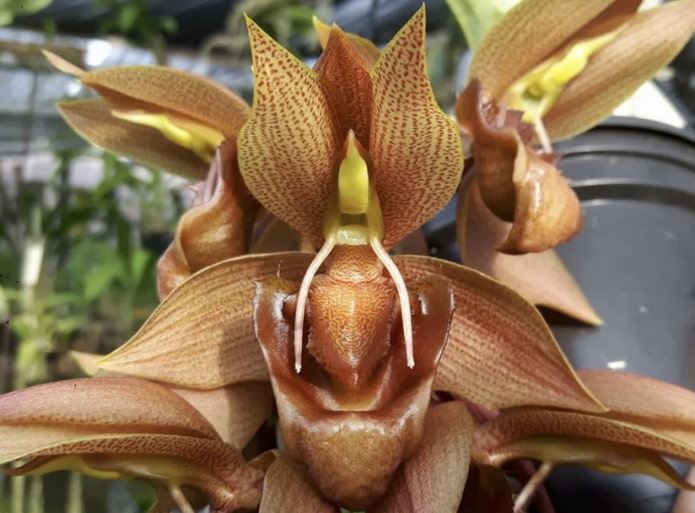
Paphiopedilum
Another name for the orchid is “Venus’s slipper”. According to legend, the goddess was in a hurry to meet her lover and lost a golden slipper in the forest. When a commoner, who noticed the loss, bent down to pick it up, it turned into an amazing flower. Paphiopedilum captivates with its appearance, sensuality and grace of form. The plant is sympodial, with a short stem and a well-developed root system. Peduncles stretch up to 60 cm in length.

The flowers are large, in bright yellow-red-green shades. The lip with its bright coloring and sweet nectar on the inner walls is especially attractive to insects for pollination. The plant is native to Thailand, the Philippines, India, China and Nepal.
Miltonia
Another crazy tropical beauty, which is easy to fall in love with at first sight. Orchid flowers resemble pansies, and the pattern of the petals is such that it seems as if drops of dew are flowing down to the ground. Lush greenery, long flowering and the sophistication of the flowers have bewitched gardeners who are trying to create ideal conditions for the capricious guest.
The color of the leaves is light green, they are thin-skinned and pointed. In the photo is an epiphytic Miltonia, which received the name “daughter of the air” because it hovers above the ground. The range of colors is stunning – from snow-white to purple. Combinations of several colors with sharp contrasting transitions may be encountered.
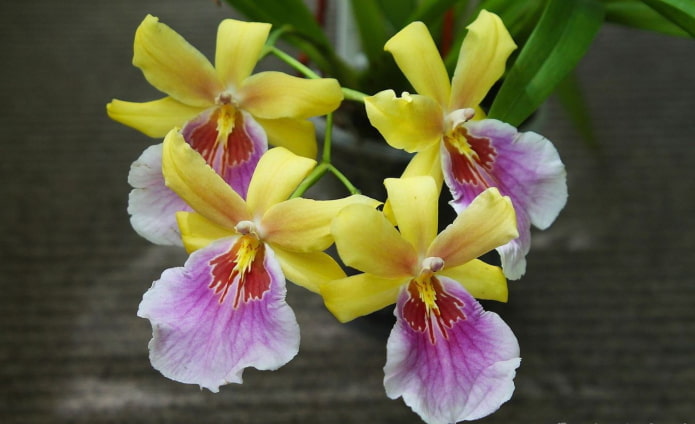
Rhynchostylis
An amazing orchid, similar to lush brushes of sirens, with a unique aroma. It is impossible to forget how the buds of Rhynchostylis bloom. Epiphytes grow, clinging with their roots to the bark of trees, in the shade of the crown, protecting from the hot sun.
The flowers are collected in hanging inflorescences, the color – from white to pink, there are also spotted specimens. The orchid’s homeland is Indonesia, the Philippines, and Southeast Asia.
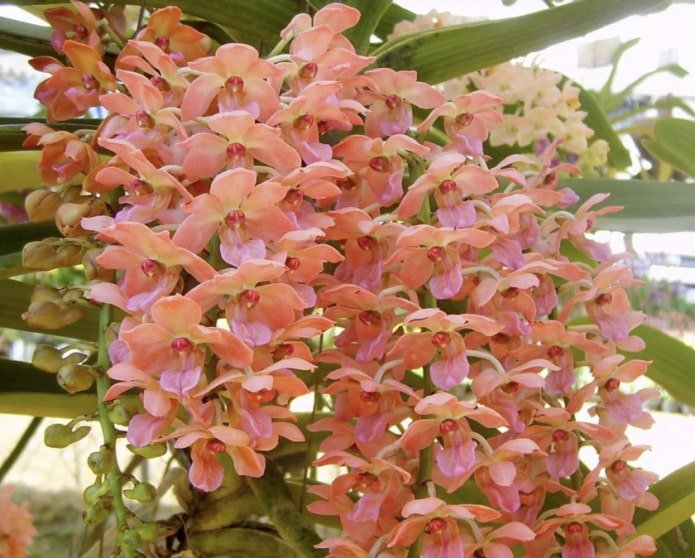
Angraecum
The most elegant aristocratic orchid, whose color varies in noble shades – snow-white and ivory, as well as yellow, green, and ocher. The orchid spreads a subtle, pleasant scent, which is especially noticeable at night. Angraecum comes from Madagascar and grows in forests with high humidity.
It can become a houseplant only in rare cases – the reason lies in the lack of light. This miracle of nature needs a 12-hour daylight. It is grown in greenhouses. Most Angraecums prefer moderate and warm temperatures. They are considered slow-growing, blooming three times a year. Admire how the white flower looks in the photo.
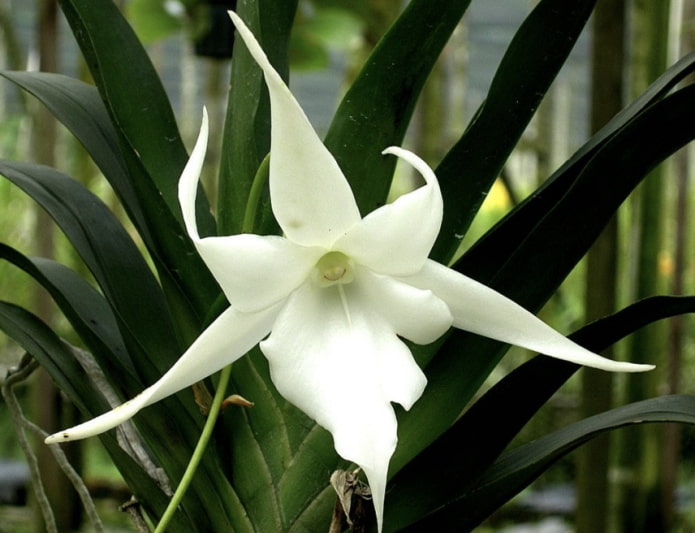
Neofinetia
Miniature orchids native to deciduous forests located in the highlands of Japan, Korea and China. Leathery leaves and snow-white, pleasantly scented flowers are collected in two-row rosettes. The flower reaches a height of 15 cm, no more. The aroma of Neofinetia is especially distinct in the evening.
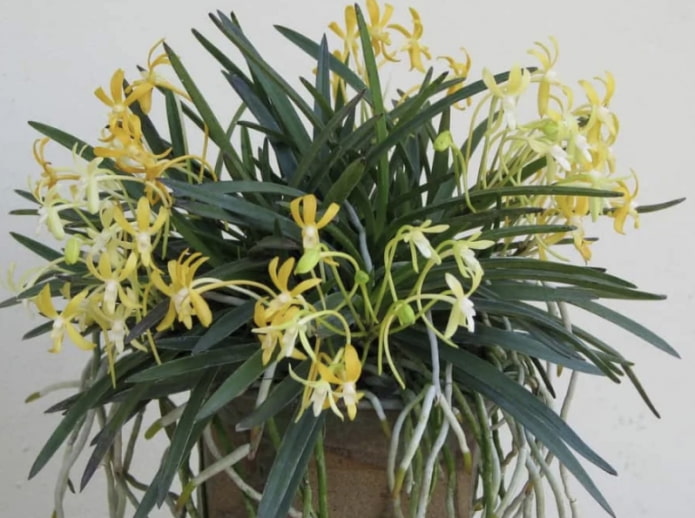
Miltoniopsis
A lovely plant with usually large, fragrant flowers. Flowering lasts for about 2 months, but you shouldn’t give bouquets of Miltoniopsis, as they quickly fade if cut. The flowers resemble pansies in appearance, the palette of inflorescences is gorgeous – the petals are painted in scarlet, purple, pink and lilac colors, finely decorated with specks and strokes.
Interesting flowering occurs only on the shoot of the current year, however, it is not recommended to remove old tubers, since they store a reserve power source.
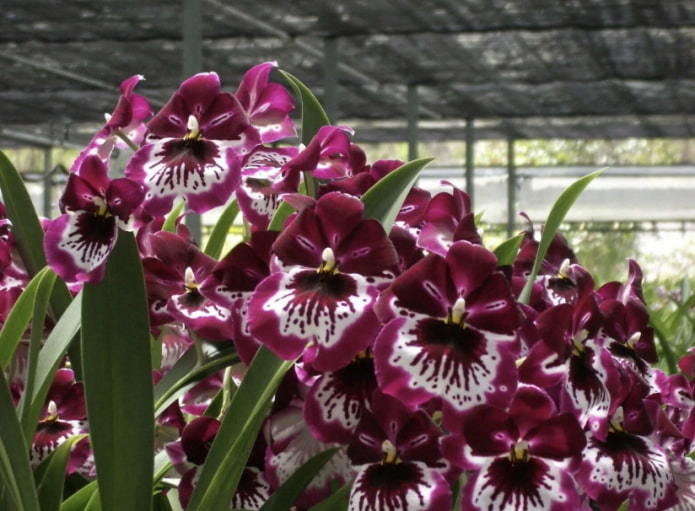
Beallara
People are not satisfied with the crazy variety of orchids. Beallara is a very spectacular flower bred by crossing Brassia, Cochlioda, Miltonia and Odontoglossum. The leaves of the representatives of the colorful variety stretch up to 20-30 cm. The color is soft or rich green, there are also plants of a herbaceous shade.
Beallara loves good lighting, but direct sunlight can harm it. Therefore, an orchid standing near a southern window is darkened with curtains. Since the flower is bred, the owner will have to experiment to provide ideal conditions, understand what temperature is optimal for it, whether this variety is heat-loving or prefers cold. Air humidity should be 50-70%. The photo shows a beautiful hybrid created by man – white, with dark cherry inclusions.
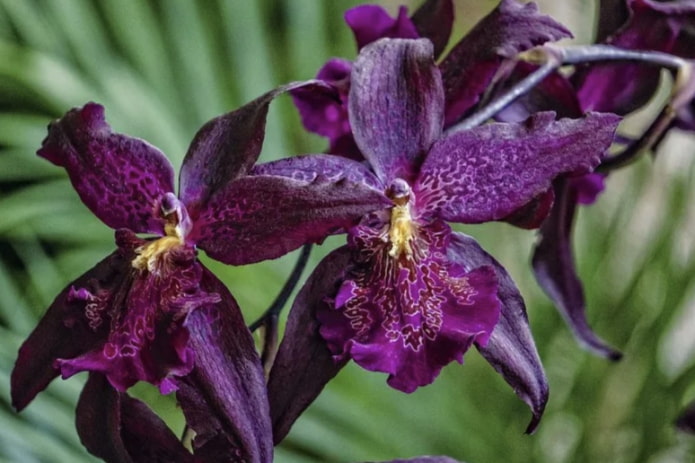
Bifrenaria
The name of the orchid is translated as “two bridles”, since regardless of whether its peduncle is long or short, no more than two not very large, juicy flowers bloom on it. The whole flower is covered with soft fluff.
The color range includes white-cream and brown shades. Bifrenaria bloom for about 2 weeks, with the buds opening one after the other. The aroma is pleasant, strong, reminiscent of caramel notes.

Calantha
The essence of the orchid is conveyed by the very name of the variety: Calantha means “beautiful flower”. The flowers are native to Asia and Central America, prefer a moist substrate and shade, and can wither from direct sunlight. Calantha petals are painted in a soft pink or snow-white color, the leaves are bright green, reach 50 cm. The peduncle is slender, can reach 60 cm.
Note! Some varieties of Calantha are frost-resistant, they can withstand even temperatures of minus 10 degrees
Look at the selection of shade-loving plants for the home.
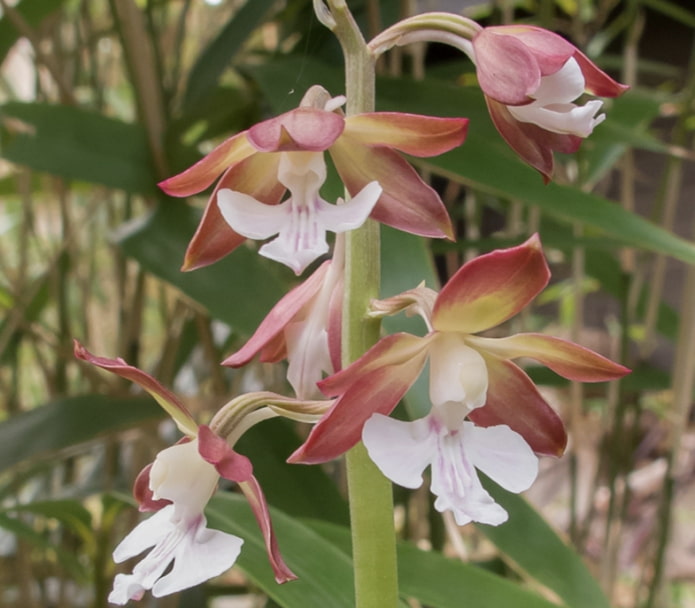
What colors are they?
There is no such color in nature, no matter what the orchid is painted. These unearthly flowers have the colors of all the colors of the rainbow. Moreover, they can be monochromatic, combined and patterned. Conventionally, all orchids can be divided into three subspecies:
1. Light:
- white;
- coral;
- peach;
- pink;
- green;
- blue.
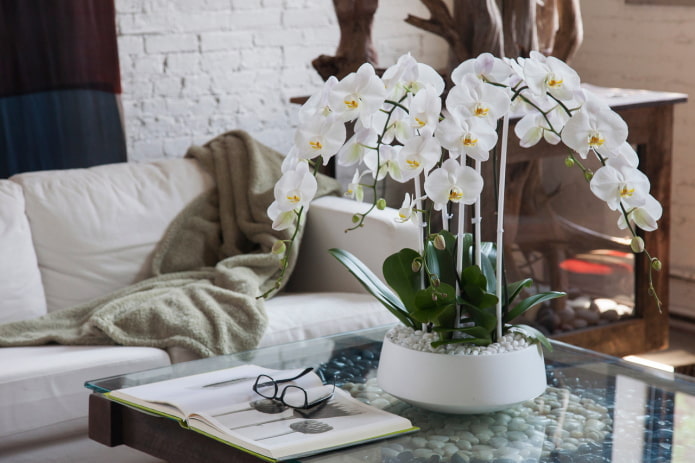
2. Bright:
- red;
- burgundy;
- orange;
- lemon.

3. Dark:
- blue;
- purple;
- black;
- brown.

There are also completely unusual varieties – gold and silver.
Varieties by leaf shape
Types of orchid leaves, depending on their shape, can be divided into many categories:
- oval;
- needle-shaped;
- lanceolate;
- rounded;
- pointed;
- ovate;
- alternate;
- blunt.
A healthy plant can be identified by its shiny leaves. It is natural that the lower leaves turn yellow and then fall off, this is typical of normal growth.
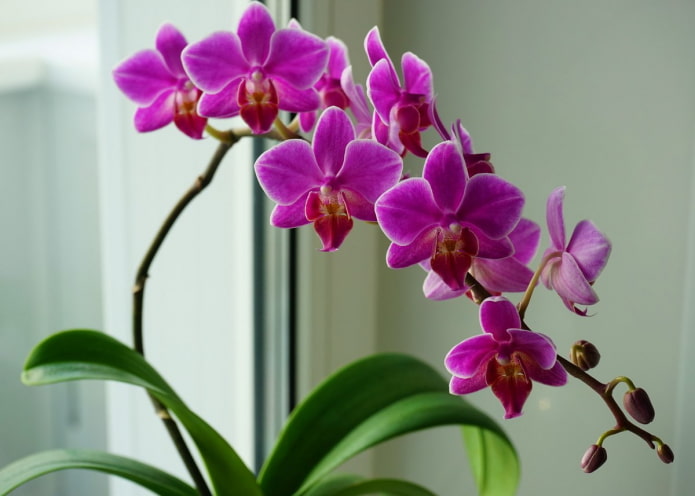
If the bright green leaves characteristic of orchids suddenly turn pale, it means that they are not getting enough light and should be moved to a more illuminated room. And, conversely, leaves with a pronounced purple tint indicate that the plant is sunburned. Then it is moved to the back of the room.
Now reading:
- Interior ideas: original use of wallpaper remnants with photos.
- Laminate on the ceiling: more than 60 photos and current decor ideas with boards.
- 12 original solutions for decorating a kitchen ventilation duct.
- Kitchen rails: details that provide coziness and comfort (33 photos)
- Kitchen handles: 30 photos, types and design selection tips.